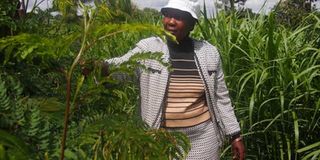Grow Sesbania for good soil fertility, fodder and medicine

Mary Gichuki in her farm in Limuru in this past photo, where she grows fodder shrubs and trees. Sesbania sesban foliage is also used as fodder for cattle, goats and sheep. PHOTO | FILE | NATION MEDIA GROUP
What you need to know:
- According to A Guide to Tree Planting in Kenya, a publication of the Kenya Forestry Research Institute, any species selected must be able to fulfil the objectives for planting it.
- Sesbania ticks many of these boxes although its potential has not been fully exploited in Kenya, unlike in its native Asian lands.
- The nutritional benefits of Sesbania make it an important constituent of any diet and this has been fully exploited in Asia.
- Bark, roots, leaves, gum and flowers are used in treatment of anaemia, bronchitis, fever and ulceration of the tongue and alimentary tract.
Sesbania sesban is native to the Asian countries of India, Sri Lanka, Malaysia, Indonesia and the Philippines but also grows widely in Africa.
Also known as hummingbird tree, it is grown across Africa, from Senegal in the west to Somalia, Egypt and South Africa.
In Kenya, it grows in ecological zones ranging from altitudes of 350m to 1,900m above sea level and annual rainfalls of between 400mm and more than 1,400mm.
It is common in riverine vegetation and the margins of fresh water lakes like Naivasha and Baringo and in many seasonal swamps.
Before I learned that Acacia xanthophloea also withstands waterlogging, Sesbania was the only tree that grew on the part of my farm in Soy that is swampy.
Benefits
According to A Guide to Tree Planting in Kenya, a publication of the Kenya Forestry Research Institute, any species selected must be able to fulfil the objectives for planting it.
These include soil and water conservation, improvement of soil fertility (supply of mulching material and green manure), animal fodder, shade and saleable products such as fruits, medicine, firewood and charcoal, timber for construction, pulp and craft materials.
Sesbania ticks many of these boxes although its potential has not been fully exploited in Kenya, unlike in its native Asian lands.
The tree improves soils by fixing nitrogen and its leaves form green manure. It does well as a cover for crops such as turmeric, ginger and vines.
Some studies have found that one-year fallow with this tree can increase maize yields from two to four tonnes per hectare without the application of nitrogen fertiliser.
But according to Useful Trees and Shrubs for Kenya by P. Maundu and B. Tengnas (World Agroforestry Centre), Sesbania harbours root-knot nematodes.
Consequently, it should be avoided in combination with crops that are sensitive to nematodes like bananas and potatoes.
Food
The nutritional benefits of Sesbania make it an important constituent of any diet and this has been fully exploited in Asia.
It is one of the best options for getting vitamins B1, C, phosphorous and iron as studies have shown one cup of Sesbania leaf juice consists high amounts of these minerals vital for the body.
In India, young leaves, flowers and pods are used in curries and soups, lightly fried, steamed or boiled. The tender pods are cooked similarly to other green beans.
The leaves, young green pods and flowers are eaten alone as a vegetable. Its seeds are high in protein (33.7 per cent).
Fodder
Sesbania sesban foliage is used as fodder for cattle, goats and sheep. A study, Sesbania sesban as a fodder tree in Ethiopian livestock farming systems, published in Livestock Science, attests to its suitability for animals.
Sesbania was introduced in the Ethiopian highlands for livestock feed and soil conservation. The study showed that supplementation with Sesbania improved intake and digestibility of basal diet and growth rate of animals.
It assessed farmers' feeding practices and their perception about effects of Sesbania supplementation on sheep performance.
It revealed that farmers perceived increased lamb birth weight and body weight gain, earlier onset of puberty and improved pregnancy rate of ewes and rams' libido.
Medicine
Sesbania is important in traditional medicine. Various parts of the tree, studies show, are used in the treatment of illnesses like rheumatism, leprosy, gout and liver disorders.
Bark, roots, leaves, gum and flowers are used in treatment of anaemia, bronchitis, fever and ulceration of the tongue and alimentary tract.
In the indigenous system of medicine in India, Sesbania bark is also used to cure diarrhoea, snakebites, dysentery, malaria, smallpox and scabies.
A tea made from the leaves is believed to have antibiotic properties. A number of herbalists have come to my Soy farm to harvest parts of this tree.
Sesbania is a key source of firewood. The trunks may be used for light construction and have been used as poles for temporary shelters and sheds.
However, they do not last long as they are vulnerable to insect attacks. In India, it is used in pulpwood production.
Propagation
Propagation is by direct sowing at site or wilding. Seeds cost Sh1,500 a kilogramme at Kenya Forest Research Institute seed shops.
They require pre-sowing treatment to soften the hard coat for faster germination. This is done by soaking in hot water for 12 - 24 hours. The tree is fast-growing and matures in about three years.




